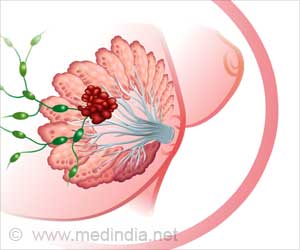- A web-based calculator has been developed to predict the risk of breast cancer returning to another part of the body, post-hormone therapy for breast cancer
- There is an increased risk of developing a late metastasis or cancer spreading in over 50 percent of women who have finished hormonal treatment for their breast cancer
- The new tool can help oncologists and patients predict women who are at highest risk and decide whether extending hormone therapy beyond five years is worthwhile and appropriate
Why was the New Tool Developed?
Current therapy for breast cancer includes standard treatment (surgery, chemotherapy, and/or radiation therapy) followed by five years of hormone therapy for almost all the patients, to lower the risk of cancer returning.Oncologists usually have to decide whether the endocrine or hormone therapy has to be continued or stopped beyond five years since the therapy can have significant side effects for some patients, including weakness of bone tissue, and worsening of menopausal symptoms.
Hormone-sensitive breast cancer is also one of the few cancers where the recurrence at a later date is common; hence, predicting who is at high risk is particularly important.
- The new tool was devised to address this problem - to decide which patients are at high enough risk of their cancer returning after receiving the hormone therapy, and so could benefit from the continuation of treatment.
- The tool has another benefit of predicting which patients are at low risk of recurrence, and so can avoid any further therapy along with the potential adverse side effects.
Study - Clinical Treatment Score Post-5-years
Clinical Treatment Score Post-5-years (CTS5) was developed after reviewing data from two previously published studies which together provided information on 11,446 postmenopausal women with ER-positive breast cancer who had received five years of hormone therapy (tamoxifen, anastrozole, or letrozole).Professor Mitch Dowsett, Head of The Royal Marsden Ralph Lauren Centre for Breast Cancer Research and Professor of Biochemical Endocrinology at The Institute of Cancer Research (ICR), and Professor Jack Cuzick and Dr. Ivana Sestak from Queen Mary University of London were instrumental in the development of the web-based tool.
They obtained the data set from one of the studies and measured the number of women who developed metastasis or cancer that had spread, five to 10 years after they finished endocrine therapy.
The validity of CTS5 was determined by testing it against the data from the second study. CTS5 could -
- Accurately separate women into groups of low, intermediate, or high risk of developing breast cancer again at a later date, after five years of hormone therapy.
- Identify that 42 percent of the women had a sufficiently low risk of recurring cancer so that extending hormone therapy would have been of very little value.
Once the patients’ details like age, tumor size and tumor grade are inputted, the calculator gives an estimated 5-10 year risk of cancer returning in another part of the woman's body, along with an estimated benefit from extending their hormone therapy.
Co-lead researcher Professor Jack Cuzick from Queen Mary University of London said: “While our ability to predict hormone sensitive breast cancer is highly likely to improve in the future, we're providing a simple tool which is available now, and is easily used and well tested. Our tool provides a very simple way of obtaining the risk of a late metastasis for each woman individually. It is very important to identify these women in the clinic and the calculator provides help in the decision-making process."
However, the data collected and used were from studies that began over 20 years ago on patients with hormone receptor-positive tumors. These studies did not use the drug trastuzumab for cancer management; hence, clinicians should be cautious when using CTS5 on the specific patient population that uses trastuzumab.
Source-Medindia
















